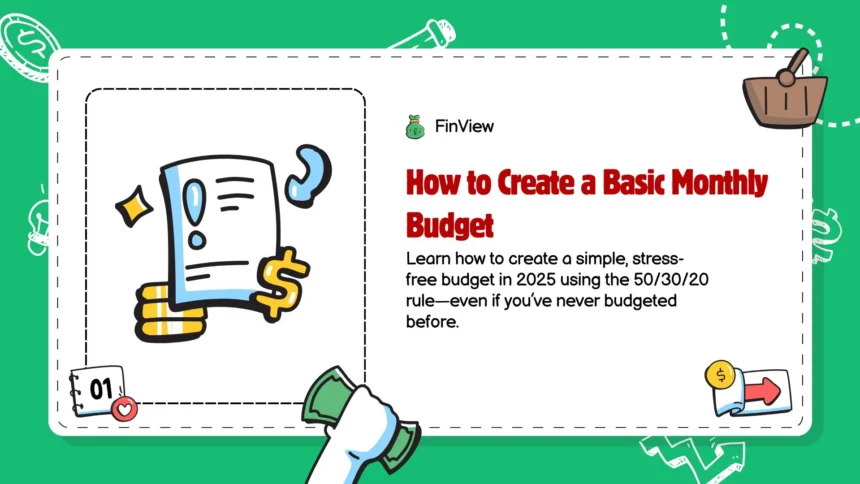If you’ve never made a budget, the whole thing can feel overwhelming. But it doesn’t have to be. In fact, with just a few steps—and one easy system—you can take full control of your money starting today.
This guide will walk you through a simple and stress-free way to set up your first budget, even if you’re not a numbers person. You’ll learn how to track your income, plan your expenses, and use the 50/30/20 rule—an easy budgeting method that actually works in real life.
Whether you’re a college student, working adult, or trying to fix your financial habits, this is for you.
Key Takeaways
- Start by writing down all your monthly income and expenses
- Use the 50/30/20 rule to divide your money: 50% Needs, 30% Wants, 20% Savings/Debt
- Categorizing spending helps spot areas where money’s leaking
- Budgeting tools like Mint or Google Sheets can simplify the process
- A smart budget is your first step to building an emergency fund and escaping the paycheck-to-paycheck cycle
What Is a Budget and Why You Need One in 2025
A budget is just a plan for how you’ll spend your money each month. That’s it. It shows what’s coming in, what’s going out, and helps you decide where every dollar should go.
Without a budget, your money disappears quickly—little by little. Especially in 2025, with inflation still high and housing, gas, and food costs rising, having a budget isn’t just smart, it’s necessary.
According to recent data from the U.S. Bureau of Labor Statistics, the average American household spends over $5,500 a month—much of that untracked. Imagine if you could find just $200 of that and reassign it toward debt or savings. That’s what budgeting can help you do.
Step 1 – List All Your Monthly Income
Before anything else, you need to know exactly how much money you bring in. That means:
- Paychecks (after taxes)
- Side hustle income
- Freelance or gig earnings
- Government benefits like child tax credits or disability
- Alimony or financial support
If your income changes from month to month, try using your lowest average from the past 3–6 months. That way, you’re planning based on your safest baseline.
Here’s a simple table you can use:
| Income Source | Monthly Amount ($) |
|---|---|
| Full-time Job | 2,800 |
| Freelance Projects | 500 |
| Child Tax Credit | 250 |
| Total | 3,550 |
This is your starting number. Everything else in your budget will be based on it.
Step 2 – Track Your Monthly Expenses
Now it’s time to look at where your money is going. Expenses typically fall into two buckets:
- Fixed expenses: Rent, loan payments, insurance
- Variable expenses: Groceries, gas, dining out, entertainment
You can track expenses manually by reviewing bank and credit card statements, or you can use tools like YNAB, Mint, or Google Sheets to help automate the process.
Be honest here. If you’re spending $150 on takeout, write it down. This step is all about awareness—not judgment.
Here’s a sample of what this might look like:
| Expense | Monthly Amount ($) | Type |
|---|---|---|
| Rent | 1,200 | Fixed |
| Utilities | 180 | Fixed |
| Groceries | 450 | Variable |
| Eating Out | 200 | Variable |
| Subscriptions | 80 | Variable |
| Loan Payment | 300 | Fixed |
| Total | 2,410 |
Step 3 – Categorize Using the 50/30/20 Budget Rule

The 50/30/20 rule is a simple framework for dividing your income.
50% – Needs
These are your must-haves. They include:
- Rent or mortgage
- Utilities
- Groceries (not junk food, just basics)
- Transportation (car payment, fuel, bus fare)
- Health insurance and prescriptions
If you’re spending more than 50% on needs, it’s okay—but look for areas to trim or shift over time.
30% – Wants
This is where most people overspend. Wants include:
- Streaming services
- Eating out
- Shopping
- Gym memberships
- Weekend getaways
The goal here isn’t to cut out all fun—just to put a cap on it. Even cutting $100 here can go a long way.
20% – Savings & Debt
This is your freedom category. You use it to:
- Build an emergency fund
- Pay off debt
- Save for retirement or goals
If you’re not sure how much you need saved, check out Ramsey Solutions’ budget breakdown or our guide on calculating monthly living expenses (internal link placeholder).
Step 4 – Set Realistic Spending Limits
Now that you’ve got a clear picture of income and expenses, you can start assigning limits. Use your real spending habits to guide your budget — not your ideal ones (yet).
Here’s what a basic budget for someone earning $3,000 a month might look like:
| Category | % of Income | Budgeted Amount ($) |
|---|---|---|
| Needs | 50% | 1,500 |
| Wants | 30% | 900 |
| Savings & Debt | 20% | 600 |
| Total | 100% | 3,000 |
These numbers aren’t perfect, but they give you a real framework to adjust based on your own lifestyle.
Step 5 – Choose a Budgeting Method That Works for You
No two people budget the same way. What matters is finding a system that you’ll actually stick with.
Spreadsheet (Manual)
If you love control and don’t mind entering numbers, Excel or Google Sheets are powerful. You can customize categories and run totals yourself.
Budgeting Apps
Apps like Mint or YNAB do the math for you. These are great if you want alerts, visuals, and automation without too much effort.
Cash Envelope System
Old-school but effective. You use physical envelopes for spending categories like groceries, gas, and entertainment. When the envelope is empty, you stop spending.
It’s a bit intense—but amazing if you’re a tactile learner or overspender.
Step 6 – Review and Adjust Monthly
Your first budget won’t be perfect, and that’s normal. What matters most is checking in monthly and making small adjustments.
Did you spend too much on coffee? Maybe reduce next month’s “wants” and reallocate. Did your rent go up? Adjust your “needs” and reduce elsewhere.
Budgeting is more like tuning a guitar than setting stone. You keep adjusting until it sounds (and feels) right.
How Budgeting Helps Build an Emergency Fund
Without a budget, it’s nearly impossible to save. Once you start tracking spending, you’ll find extra dollars hiding in places you never expected.
That’s where your emergency fund begins.
Aim to save $1,000 first. Then work toward 3 to 6 months of living expenses. Use the 20% savings category in your 50/30/20 budget for this. We go deeper in our guide on “How to Calculate Your Monthly Living Expenses” (internal link placeholder).
Your emergency fund is your safety net. Budgeting is how you weave it together.
Common Mistakes to Avoid When Creating a Budget
- Forgetting irregular expenses like yearly car tags or holiday gifts
- Setting unrealistic spending caps—then feeling guilty
- Not tracking “wants” and letting them creep into “needs”
- Ignoring small leaks like late fees or app subscriptions
- Skipping monthly reviews that keep your budget accurate
Mistakes happen. Just adjust and keep going.
Final Thoughts – Your Budget Is Your Financial Foundation
You don’t need to get it perfect on day one. Just starting puts you ahead of most people.
Budgeting helps you feel more in control. It gives you permission to spend wisely and save confidently. The best time to start was yesterday. The next best time is right now.
Keep exploring our site for more tools, templates, and tips to help you stay in control of your money—for good.


